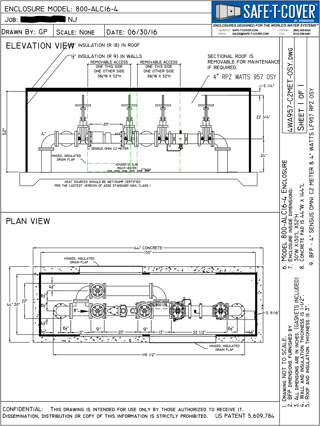The most common location for non-residential water meters in northern states is inside a building. Why are New Jersey water systems now requiring new non-residential meters and containment backflow preventers to be installed aboveground at the curb? It stems from New Jersey’s interpretation of the Federal Pipeline Safety Act. Recent responses by the New Jersey Board of Public Utilities to comments for the re-adoption of the state rule reveal New Jersey’s position that, “Federal standards for state one-call programs call for the inclusion of all underground facility operators. Under the One-Call statute, if a utility delivers metered service, it controls the operation of the utility line up to (and often including) the meter, regardless of who owns the line.”
New Reasons for Common Practice
Every state has an "811 One Call," "Call Before You Dig," or "Know What's Below" service. This is based on the funding  provided by the Federal Pipeline Safety Act. The programs are for utilities including water, gas, and electric services. It's common practice for gas and electric to include marking of the service line by the 811 representatives from the tap to the meter, even when the meter is located at or inside the building. Doing the same for water services - marking the water system to the meter - ends up putting a high burden on the Public Water System (PWS) when they are located inside. It is much easier to manage when the meter is installed outside, preferably at the property line.
provided by the Federal Pipeline Safety Act. The programs are for utilities including water, gas, and electric services. It's common practice for gas and electric to include marking of the service line by the 811 representatives from the tap to the meter, even when the meter is located at or inside the building. Doing the same for water services - marking the water system to the meter - ends up putting a high burden on the Public Water System (PWS) when they are located inside. It is much easier to manage when the meter is installed outside, preferably at the property line.
Some northern water systems have installed non-residential combination lines with fire meters and backflow preventers aboveground for years. The reasons normally are based on access for testing and maintenance. These water systems prefer not to endure the difficulty of access and lack of room to work on meters in crowded mechanical rooms. In New Jersey, the interpretation of the Federal Pipeline Safety Act has given them another reason to make meters more easily accessible. Why does the New Jersey Board of Public Utilities require this interpretation? The board responses included many reasons to protect the public including “Board staff has investigated incidents in which it has concluded that unmarked water underground facilities contributed to the loss of life, property damage, and injuries to the public.”
Water system and backflow prevention trends are always changing. Keep up with the latest in this free guide.
Lofty Goals come with a lofty price
So why would this change be a concern for water systems? Some New Jersey water systems complete 200,000 or more mark outs each year. The cost to create these extended mark-outs to the water meter is born by the water system and its rate payers. In addition to the added costs, New Jersey water systems objected to what their attorney described as “liability exposure of unknown magnitude”. One attorney commented, “the costs associated with compliance for all water companies in the State will exceed $10,000,000”.
NJ's Solution
How can the water systems manage their costs and liability exposure for these extended water system mark outs? We see new standard details requiring new non-residential meters and containment backflow preventers to be installed aboveground close to the curb where the marks out requirements are simple and easy. As you can see in the image to the right, we recently completed a design for a project in NJ that meets their new requirements. This change is also providing the added benefit of improved access for meter maintenance and annual testing of the backflow preventer. You can read more about containment vs isolation backflow prevention here.
Operations staff for water utilities can reduce their annual maintenance expenses when non-residential meters are located at the curb. The same is true for the rate payer’s cost to have the containment backflow preventer tested each year when they are located at the curb. No knocking on the doors of businesses. No waiting for access to their interior mechanical room – often then just to find the owner’s room is so cluttered the work must be postponed yet again and another visit will be required. These new designs are a simple solution to a long over-complicated problem.
A changing pws landscape
Drinking water is no longer looked upon as an inexpensive commodity in many states. Many water systems are evaluating their water infrastructure and water system assets to best protect the water quality and the water supply. They are considering long term benefits to the rate payers, as well as the longevity of the water system. There may be other states that have already adopted these requirements for water system mark outs. We expect state legislatures around the US will be considering this interpretation to better protect their communities and the public interest. Water systems will be considering their standards for non-residential meter and containment backflow installations in light of these changes.




